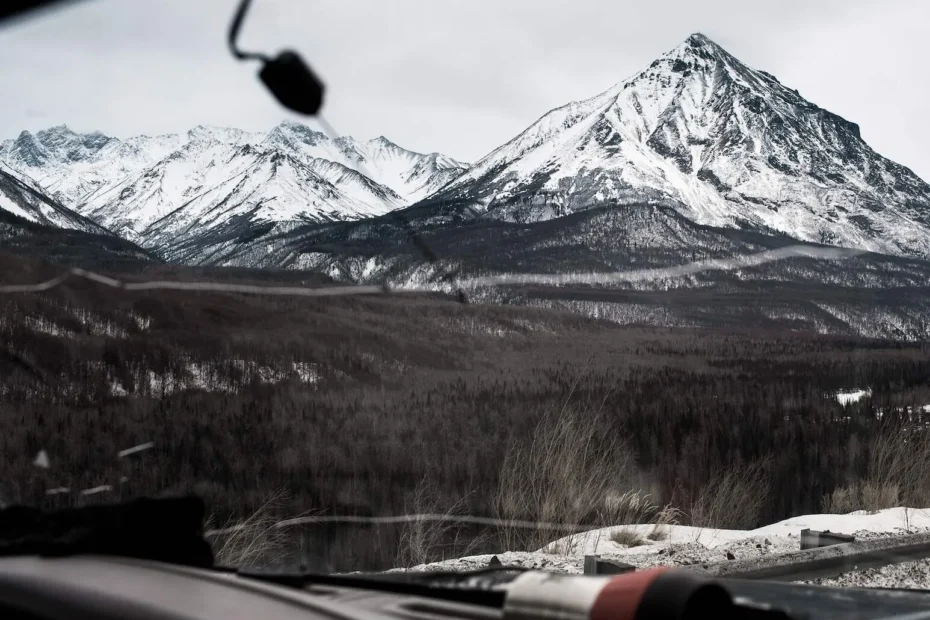To winterize a car for Alaska, ensure antifreeze protection and install winter tires. Check the battery, change oil to a winter-grade, and prepare an emergency kit.
Preparing your car for Alaska’s harsh winter conditions is essential for safe and reliable transportation. The frigid temperatures, snow, and ice present unique challenges for any vehicle. As the mercury plummets, it’s not just about comfort but also about survival.
You’ll want to fortify your car against the extreme cold to prevent breakdowns and maintain performance. From choosing the right antifreeze to ensuring your tires can grip the slippery roads, winterizing your car is a multifaceted process. It’s not just the mechanics; an emergency kit with supplies can be a lifesaver in case of an unforeseen situation. Take proactive measures now to guarantee your vehicle is ready to face the Alaskan winter with confidence.

Credit: www.johnsautocareboulder.com
Preparing For Alaskan Winters
Preparing for Alaskan Winters means gearing up for one of the most challenging driving conditions on the planet. Alaskan roads can transform into icy trails. This calls for special care of your vehicle. Read on to make sure your car stands up to Alaska’s extreme weather.
Climate Challenges In Alaska
- Sub-zero temperatures
- Heavy snowfall
- Black ice on roads
- Reduced visibility due to blizzards
In Alaska, daylight dips and temperatures plummet. Your car must tackle below-freezing conditions, slick surfaces, and unexpected snowstorms. These require not just skillful driving but a vehicle fully equipped to handle the ice and snow.
Why Winterize Your Vehicle?
- Prevent breakdowns in the cold
- Ensure safety on icy roads
- Maintain visibility during snowfall
- Keep your car running efficiently
Winterizing your car is crucial. The right preparations save time, money, and lives. A winter-ready vehicle ensures you stay in control. It keeps you safe. It spares you from the risk of roadside emergencies in freezing conditions.

Credit: thedyrt.com
Starting With The Basics
Preparing your car for Alaska’s winter demands attention to detail. Let’s start with the essentials, making sure your vehicle stays reliable in extreme conditions.
Battery Health Check
Alaska’s cold is tough on batteries.
- Test the battery for strength and charge.
- Inspect for corrosion and clean terminals.
- Ensure cable connections are snug and secure.
- If the battery is old, consider a replacement.
A healthy battery is crucial for reliable starts.
Professional tests provide peace of mind.
Changing To Winter-grade Oil
Oil thickens in the cold.
Winter-grade oil stays fluid at lower temperatures. This helps your engine turn over easily, even in the coldest weather. Here’s how to switch:
- Check your owner’s manual for recommended oil type.
- Choose oil that meets the viscosity for Alaska’s winter.
- Schedule an oil change or do it yourself before winter hits.
Remember, thin oil in winter keeps engines happy.
Upgrading For The Season
Preparing your vehicle for Alaska’s winter is crucial. Frigid temperatures, ice, and snow demand robust solutions. Start with specific upgrades. Your car will become a reliable companion, even in the harshest conditions. Safety and performance are our focus here.
Specialized Winter Tires
The right tires make all the difference on snowy roads. Consider winter tires a must-have in Alaska. Look for:
- Deep treads: They grip snow and ice better.
- Flexible rubber compounds: They stay soft in the cold.
- Bite particles: They provide extra traction.
Not all tires are equal. Look for the “Three-Peak Mountain Snowflake” symbol. It means they meet specific winter performance standards.
Remember to check your tire pressure monthly, as it drops in cold weather.
Antifreeze: Your Car’s Winter Jacket
Antifreeze keeps your engine safe from freezing temperatures. Refilling it is crucial. It’s a simple check that offers significant protection. Proper antifreeze levels ensure:
| Benefit | Detail |
|---|---|
| Engine Protection | Prevents water from freezing and cracking the engine block. |
| Temperature Regulation | Helps maintain the ideal engine temperature even in sub-zero conditions. |
| Corrosion Prevention | Special additives help prevent rust and corrosion inside the engine components. |
Use a 50/50 mix of antifreeze and water for optimal performance. Consult your owner’s manual or a professional to find the best type for your vehicle.

Credit: kristitrimmer.com
Visibility In Snow And Ice
Keeping your car visible in Alaska’s snowy embankment is critical. Snow and ice can impair visibility, making safe driving a challenge. Let’s focus on essentials that enhance visibility during the harsh winter months. Clear vision and being seen are vital for your safety on the road.
Windshield Care Essentials
Caring for your windshield is a top priority. Follow these steps to ensure clear visibility in snowy conditions:
- Install winter wipers with thick rubber that won’t freeze.
- Fill up with antifreeze washer fluid to melt ice quickly.
- Keep an ice scraper handy to clear your windshield before each drive.
- Check for cracks or chips and repair them to prevent spreading.
Headlight And Tail Light Considerations
Effective lighting is crucial for driving in Alaska’s winter. Here are key considerations for your car’s lights:
| Light Type | Cleaning | Maintenance |
|---|---|---|
| Headlights | Wipe regularly to remove snow and grime | Replace bulbs before they burn out |
| Tail Lights | Check for dirt build-up and clean | Ensure all bulbs work and are bright enough |
- Upgrade to LED lights for better visibility and longer life.
- Aim your headlights correctly so they’re not blinding other drivers.
Emergency Preparedness Kit
Driving through Alaska’s winter demands respect for the cold and unknown. An Emergency Preparedness Kit isn’t a luxury—it’s a necessity for safety and peace of mind. Whether stranded or just handling daily winter challenges, this kit can make all the difference. Let’s pack the perfect emergency kit for Alaska’s harshest months.
Must-have Items
Essential items ensure survival and comfort in winter emergencies. Start with these:
- Flashlight with extra batteries
- First-aid kit for minor injuries
- Blankets or sleeping bags for warmth
- Food and water: Non-perishable snacks and bottled water
- Jumper cables: A lifeline for a dead battery
| Item | Quantity | Notes |
|---|---|---|
| Hand Warmers | 4 pairs | Stick-on type preferred |
| Windshield Scraper | 1 | Heavy-duty with a brush |
| Tow Strap | 1 | For pulling or being pulled out of snow |
Survival Gear For The Unexpected
Gear up for worst-case scenarios. A few extra items can save lives. Include these for true peace of mind:
- Fire extinguisher: Critical in case of a fire
- Road flares: Make your vehicle visible in a snowstorm
- Multi-tool: Versatile for many situations
Remember, road conditions can change in the blink of an eye. Stay prepared, stay warm, and ensure you have the right gear. Your car’s winter Emergency Preparedness Kit could mean the difference between a story to tell and a situation to regret. Drive safe and smart!
Regular Maintenance And Checks
Maintaining a car in Alaska’s winter demands attention to detail. The cold temperatures can tax your vehicle, so routine checks become crucial. To ensure your car runs smoothly through the ice and snow, consistent maintenance is key. Let’s delve into the essential pre-winter scheduled services and self-inspection routines to winterize your vehicle effectively.
Scheduled Services Pre-winter
Before the harsh Alaskan winter sets in, schedule a thorough service appointment for your car. This ensures all systems can handle the extreme cold.
- Fluid Check: Mechanics should replace or top off all fluids, including antifreeze, brake fluid, and oil.
- Battery Test: A strong battery is vital. The cold can drain its power faster.
- Tire Examination: Proper winter tires are a must. The right tread depth will improve grip on icy roads.
- Brake Inspection: Reliable brakes can make a huge difference in snowy conditions.
Complete this check at least a month before winter arrives. This gives you time to address any issues that may arise from the inspection.
Self-inspection Routines
Regular checks at home keep your car in top shape between professional services. Pay close attention to the following aspects:
| Item | Frequency | Action |
|---|---|---|
| Tire Pressure | Weekly | Adjust to the recommended PSI for colder temperatures |
| Lights and Signals | Weekly | Ensure all are functioning to maintain visibility |
| Windshield Wipers and Fluid | As Needed | Top off fluid and replace blades if worn out |
| Heating System | Regularly | Check for proper function to stay warm and defrost windows |
Review these elements before each trip. Cold temperatures can cause unexpected changes overnight. Always carry an emergency kit with blankets, food, water, and tools.
Frequently Asked Questions Of How To Winterize A Car For Alaska
What Essentials Are Needed To Winterize A Car?
To winterize a car, you’ll need antifreeze, a strong battery, winter-grade oil, new wiper blades, a robust windshield washer fluid, and snow tires. These essentials ensure your car operates efficiently in cold and icy conditions.
How Often Should I Check My Antifreeze In Alaska?
In Alaska, check your antifreeze at least every autumn before winter sets in. Given the extreme cold, monitoring its levels and concentration every few weeks during winter is advisable to avoid freezing issues.
Can I Use All-season Tires In Alaskan Winter?
All-season tires are not recommended for Alaskan winters. Specialized winter tires with deep tread are essential for adequate traction on snow and ice. They significantly improve safety by reducing the risk of accidents.
What Are The Risks Of Not Winterizing My Car?
Not winterizing your car increases risks of mechanical failures, including frozen fuel lines, decreased battery life, and inadequate tire traction. This can lead to dangerous driving conditions and potential breakdowns in harsh Alaskan weather.
Conclusion
As the Alaskan winter approaches, preparing your car is essential. Follow these steps to ensure a reliable, safe vehicle amidst harsh conditions. Regular maintenance and proper winterization can save lives and prevent breakdowns. Equip your car for the cold—peace of mind is worth it.
Stay safe and enjoy the winter wonderland!

